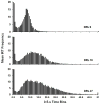Differential reinforcement of low rates differentially decreased timing precision
- PMID: 29608943
- PMCID: PMC5963708
- DOI: 10.1016/j.beproc.2018.02.022
Differential reinforcement of low rates differentially decreased timing precision
Abstract
Timing processes have been implicated as potential mechanisms that underlie self-controlled choice. To investigate the impact of an intervention that has been shown to increase self-controlled choice on timing processes, accuracy and precision of temporal discrimination were assessed in an 18-s peak procedure (18-s fixed interval trials; 54-s peak trials). During an intervention phase, mice in three treatment groups experienced differential reinforcement of low rate (DRL) schedules of reinforcement of 27 s, 18 s, or 9 s. A fourth group received continued exposure to the peak procedure. After the DRL intervention, timing was reassessed using the peak procedure. In contrast to previous reports, the DRL intervention resulted in less precise timing as indicated by increased peak spread and disrupted single-trial measures of temporal control. These effects were only detected just after the DRL intervention suggesting a transient effect of DRL exposure on timing. The increase in peak spread in the present experiment suggests delay exposure via DRL schedules may produce a "dose-dependent" effect on temporal discrimination, which may also increase self-controlled choice.
Keywords: DRL intervention; Interval timing; Mice; Peak procedure.
Copyright © 2018 Elsevier B.V. All rights reserved.
Conflict of interest statement
Conflicts of Interest: None
Figures





References
-
- Ainslie G. Specious reward: A behavioral theory of impulsiveness and impulse control. Psych Bull. 1975;82:463–496. - PubMed
-
- Catania AC. Reinforcement schedules and psychophysical judgements: A study of some temporal properties of behavior. In: Schoenfled WN, editor. The theory of reinforcement schedules. New York: Appleton-Century-Crofts; 1970.
-
- Church RM, Meck WH, Gibbon J. Application of scalar timing theory to individual trials. J Exp Psych: Anim Behav Processes. 1994;20:135–155. - PubMed
MeSH terms
Grants and funding
LinkOut - more resources
Full Text Sources
Other Literature Sources

